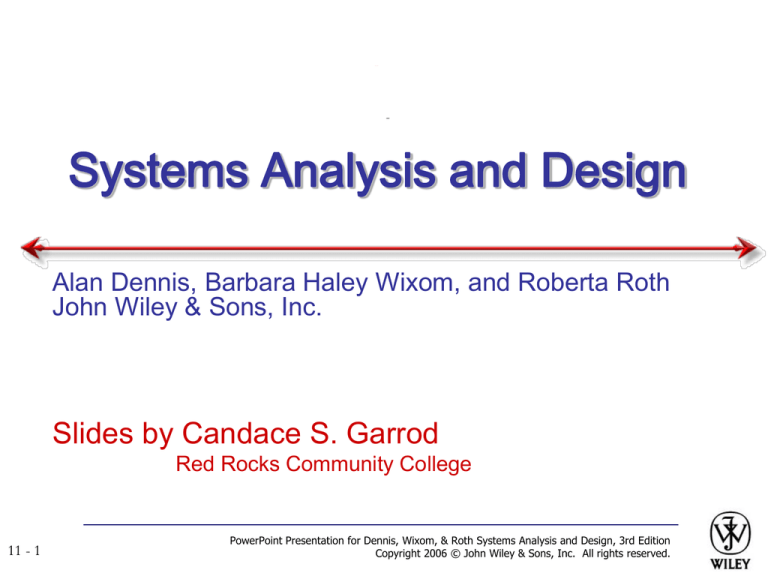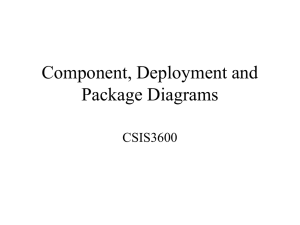
Systems Analysis and Design
Alan Dennis, Barbara Haley Wixom, and Roberta Roth
John Wiley & Sons, Inc.
Slides by Candace S. Garrod
Red Rocks Community College
11 - 1
PowerPoint Presentation for Dennis, Wixom, & Roth Systems Analysis and Design, 3rd Edition
Copyright 2006 © John Wiley & Sons, Inc. All rights reserved.
Program Design
Chapter 11
11 - 2
PowerPoint Presentation for Dennis, Wixom, & Roth Systems Analysis and Design, 3rd Edition
Copyright 2006 © John Wiley & Sons, Inc. All rights reserved.
Key Definitions
Program design - creating
instructions for the programmers
The top-down, modular approach begin with the “big picture” and
gradually add detail
Program design document – all
structure charts and specifications
needed by programmers to
implement the system
11 - 3
PowerPoint Presentation for Dennis, Wixom, & Roth Systems Analysis and Design, 3rd Edition
Copyright 2006 © John Wiley & Sons, Inc. All rights reserved.
MOVING FROM LOGICAL TO
PHYSICAL PROCESS MODELS
Analysis phase – focus on logical
processes and data flows
Design phase – create physical
process models showing “how” the
final system will work
Physical process models convey the
“system view” of the new system
11 - 4
PowerPoint Presentation for Dennis, Wixom, & Roth Systems Analysis and Design, 3rd Edition
Copyright 2006 © John Wiley & Sons, Inc. All rights reserved.
The Physical Data Flow Diagram
The physical DFD contains the
same components as the logical
DFD, and the same rules apply
There are five steps to perform to
make the transition to the physical
DFD
11 - 5
PowerPoint Presentation for Dennis, Wixom, & Roth Systems Analysis and Design, 3rd Edition
Copyright 2006 © John Wiley & Sons, Inc. All rights reserved.
Steps to Create the Physical Data Flow
Diagram
11 - 6
PowerPoint Presentation for Dennis, Wixom, & Roth Systems Analysis and Design, 3rd Edition
Copyright 2006 © John Wiley & Sons, Inc. All rights reserved.
The Physical Data Flow Diagram (The How)
11 - 7
PowerPoint Presentation for Dennis, Wixom, & Roth Systems Analysis and Design, 3rd Edition
Copyright 2006 © John Wiley & Sons, Inc. All rights reserved.
11 - 8
PowerPoint Presentation for Dennis, Wixom, & Roth Systems Analysis and Design, 3rd Edition
Copyright 2006 © John Wiley & Sons, Inc. All rights reserved.
11 - 9
PowerPoint Presentation for Dennis, Wixom, & Roth Systems Analysis and Design, 3rd Edition
Copyright 2006 © John Wiley & Sons, Inc. All rights reserved.
DESIGNING PROGRAMS
11 - 10
PowerPoint Presentation for Dennis, Wixom, & Roth Systems Analysis and Design, 3rd Edition
Copyright 2006 © John Wiley & Sons, Inc. All rights reserved.
Designing Programs
Resist temptation to write code to
quickly
System quality is enhanced with topdown, modular design
Program design document is the
final deliverable for this task
11 - 11
PowerPoint Presentation for Dennis, Wixom, & Roth Systems Analysis and Design, 3rd Edition
Copyright 2006 © John Wiley & Sons, Inc. All rights reserved.
Using a Top-Down Modular Approach
11 - 12
PowerPoint Presentation for Dennis, Wixom, & Roth Systems Analysis and Design, 3rd Edition
Copyright 2006 © John Wiley & Sons, Inc. All rights reserved.
STRUCTURE CHART
11 - 13
PowerPoint Presentation for Dennis, Wixom, & Roth Systems Analysis and Design, 3rd Edition
Copyright 2006 © John Wiley & Sons, Inc. All rights reserved.
The Structure Chart
Important program design technique
Shows all components of code in a
hierarchical format
Sequence
Selection
Iteration
11 - 14
PowerPoint Presentation for Dennis, Wixom, & Roth Systems Analysis and Design, 3rd Edition
Copyright 2006 © John Wiley & Sons, Inc. All rights reserved.
Structure Chart Example
11 - 15
PowerPoint Presentation for Dennis, Wixom, & Roth Systems Analysis and Design, 3rd Edition
Copyright 2006 © John Wiley & Sons, Inc. All rights reserved.
Structure Chart Elements
11 - 16
PowerPoint Presentation for Dennis, Wixom, & Roth Systems Analysis and Design, 3rd Edition
Copyright 2006 © John Wiley & Sons, Inc. All rights reserved.
Building the Structure Chart
Processes in the DFD tend to represent
one module on the structure chart
Afferent processes – provide inputs to
system
Central processes – perform critical system
operations
Efferent processes – handle system outputs
The DFD leveling can correspond to the
structure chart hierarchy
11 - 17
PowerPoint Presentation for Dennis, Wixom, & Roth Systems Analysis and Design, 3rd Edition
Copyright 2006 © John Wiley & Sons, Inc. All rights reserved.
Types of Structure Charts
Transaction structure – control
module calls subordinate modules,
each of which handles a particular
transaction
Many afferent processes
Few efferent processes
Higher up levels of structure chart
Using inputs to create a new output
11 - 18
PowerPoint Presentation for Dennis, Wixom, & Roth Systems Analysis and Design, 3rd Edition
Copyright 2006 © John Wiley & Sons, Inc. All rights reserved.
Transaction Structure
11 - 19
PowerPoint Presentation for Dennis, Wixom, & Roth Systems Analysis and Design, 3rd Edition
Copyright 2006 © John Wiley & Sons, Inc. All rights reserved.
Transform Structure
This structure has a control module
that calls several subordinate
modules in sequence after which
something “happens.”
These modules are related because
together they form a process that
transforms some input into an
output.
11 - 20
PowerPoint Presentation for Dennis, Wixom, & Roth Systems Analysis and Design, 3rd Edition
Copyright 2006 © John Wiley & Sons, Inc. All rights reserved.
Transform versus Transaction Structures
11 - 21
PowerPoint Presentation for Dennis, Wixom, & Roth Systems Analysis and Design, 3rd Edition
Copyright 2006 © John Wiley & Sons, Inc. All rights reserved.
Steps in Building the Structure Chart
1. Identify top level modules and
decompose them into lower levels
2. Add control connections
3. Add couples
4. Review and revise again and again
until complete
11 - 22
PowerPoint Presentation for Dennis, Wixom, & Roth Systems Analysis and Design, 3rd Edition
Copyright 2006 © John Wiley & Sons, Inc. All rights reserved.
PowerPoint Presentation for Dennis, Wixom, & Roth Systems Analysis and Design, 3rd Edition
Copyright 2006 © John Wiley & Sons, Inc. All rights reserved.
PowerPoint Presentation for Dennis, Wixom, & Roth Systems Analysis and Design, 3rd Edition
Copyright 2006 © John Wiley & Sons, Inc. All rights reserved.
11 - 25
PowerPoint Presentation for Dennis, Wixom, & Roth Systems Analysis and Design, 3rd Edition
Copyright 2006 © John Wiley & Sons, Inc. All rights reserved.
Design Guidelines
High quality structure charts result in
programs that are modular, reusable
and easy to implement.
Measures include:
Cohesion
Coupling
Appropriate levels of fan-in and fan-out
11 - 26
PowerPoint Presentation for Dennis, Wixom, & Roth Systems Analysis and Design, 3rd Edition
Copyright 2006 © John Wiley & Sons, Inc. All rights reserved.
Types of Cohesion (GPA = grade point average)
11 - 27
PowerPoint Presentation for Dennis, Wixom, & Roth Systems Analysis and Design, 3rd Edition
Copyright 2006 © John Wiley & Sons, Inc. All rights reserved.
Cohesion Decision Tree
(Adopted From Page-Jones, 1980)
11 - 28
PowerPoint Presentation for Dennis, Wixom, & Roth Systems Analysis and Design, 3rd Edition
Copyright 2006 © John Wiley & Sons, Inc. All rights reserved.
Factoring
Process of dealing with “low”
cohesion
Separates tasks into different
modules
Reduces use of control flags
11 - 29
PowerPoint Presentation for Dennis, Wixom, & Roth Systems Analysis and Design, 3rd Edition
Copyright 2006 © John Wiley & Sons, Inc. All rights reserved.
Types of Coupling
11 - 30
PowerPoint Presentation for Dennis, Wixom, & Roth Systems Analysis and Design, 3rd Edition
Copyright 2006 © John Wiley & Sons, Inc. All rights reserved.
Your Turn
What, if anything, happens to
coupling when you create modules
that are more cohesive?
What, if anything happens to the
cohesiveness of modules when you
lower the coupling among them?
11 - 31
PowerPoint Presentation for Dennis, Wixom, & Roth Systems Analysis and Design, 3rd Edition
Copyright 2006 © John Wiley & Sons, Inc. All rights reserved.
Examples of Fan-in and Fan-out
11 - 32
PowerPoint Presentation for Dennis, Wixom, & Roth Systems Analysis and Design, 3rd Edition
Copyright 2006 © John Wiley & Sons, Inc. All rights reserved.
Quality Checklist
1. Library modules have been created where ever possible
2. The diagram has a high fan-in structure
3. Control modules have no more than 7 subordinates
4. Each module performs only one function (high cohesion)
5. Modules sparingly share information (loose coupling)
6. Data couples that are passed are actually used by the
accepting module
7. Control couples are passed from “low to high”
8. Each module has a reasonable amount of code associated
with it
11 - 33
PowerPoint Presentation for Dennis, Wixom, & Roth Systems Analysis and Design, 3rd Edition
Copyright 2006 © John Wiley & Sons, Inc. All rights reserved.
PROGRAM SPECIFICATION
11 - 34
PowerPoint Presentation for Dennis, Wixom, & Roth Systems Analysis and Design, 3rd Edition
Copyright 2006 © John Wiley & Sons, Inc. All rights reserved.
Program Specifications Content
No standard approach
Include program information
Note events that trigger actions
List inputs and outputs
Include pseudocode
Present additional notes and
comments
11 - 35
PowerPoint Presentation for Dennis, Wixom, & Roth Systems Analysis and Design, 3rd Edition
Copyright 2006 © John Wiley & Sons, Inc. All rights reserved.
Program Specification Form
11 - 36
PowerPoint Presentation for Dennis, Wixom, & Roth Systems Analysis and Design, 3rd Edition
Copyright 2006 © John Wiley & Sons, Inc. All rights reserved.
Pseudocode Example
11 - 37
PowerPoint Presentation for Dennis, Wixom, & Roth Systems Analysis and Design, 3rd Edition
Copyright 2006 © John Wiley & Sons, Inc. All rights reserved.
Process Description – Analysis and Design
11 - 38
PowerPoint Presentation for Dennis, Wixom, & Roth Systems Analysis and Design, 3rd Edition
Copyright 2006 © John Wiley & Sons, Inc. All rights reserved.
PowerPoint Presentation for Dennis, Wixom, & Roth Systems Analysis and Design, 3rd Edition
Copyright 2006 © John Wiley & Sons, Inc. All rights reserved.
Summary
The structure chart shows all of the
functional components needed in the
program at a high level. Components of
the structure chart show sequence,
selection, and iteration
Follow design guidelines regarding
cohesion, coupling, and fan-in/fan-out.
Prepare detailed specifications to
programmers including pseudocode to
show important programming structures.
11 - 40
PowerPoint Presentation for Dennis, Wixom, & Roth Systems Analysis and Design, 3rd Edition
Copyright 2006 © John Wiley & Sons, Inc. All rights reserved.
Copyright © 2006
John Wiley & Sons, Inc.
All rights reserved. Reproduction or translation of this
work beyond that permitted in Section 117 of the 1976
United States Copyright Act without the express written
permission of the copyright owner is unlawful.
Request for further information should be addressed to
the Permissions Department, John Wiley & Sons, Inc.
The purchaser may make back-up copies for his/her
own use only and not for redistribution or resale.
The Publisher assumes no responsibility for errors,
omissions, or damages, caused by the use of these
programs or from the use of the information contained
herein.
11 - 41
PowerPoint Presentation for Dennis, Wixom, & Roth Systems Analysis and Design, 3rd Edition
Copyright 2006 © John Wiley & Sons, Inc. All rights reserved.




